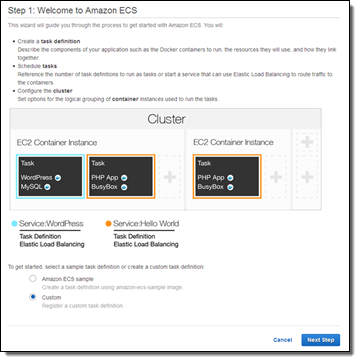We launched Amazon EC2 Container Service last fall at AWS re:Invent and made it available in production form this past April. We’ve made a lot of enhancements since then and I thought it would be a good time to recap them for you. AWS customers are already making good use of EC2 Container Service and I’d like to share some of their stories with you as well. They love the fact that they can get high performance and flexible resource scheduling without having to build, run, scale, or maintain their own clusters.
Latest Features
We have received a remarkable amount of feedback and feature requests for this product. You’ve let us know what you need by way of tweets, emails, posts in the Amazon ECS forum, blog posts, private meetings, and at the AWS Summits. We love all of this feedback and do our best to understand it and to make sure that our roadmap reflects what you tell us. Here’s what we’ve done in the first half of 2015 as we work our way along our roadmap:
 February – We added support for the use of images from private Docker repositories, along with support for mounting data volumes that can be used to share information between containers. After the initial launch in the US East (Northern Virginia) region, we made the service available in the US West (Oregon) region.
February – We added support for the use of images from private Docker repositories, along with support for mounting data volumes that can be used to share information between containers. After the initial launch in the US East (Northern Virginia) region, we made the service available in the US West (Oregon) region.- March – We continued our regional expansion, heading across the Atlantic Ocean to the Europe (Ireland) region.
- April – The service graduated to general availability, and also gained a new service scheduler for long-running applications, load balancing, rich console support, and CloudTrail integration. Expansion continued, this time with a trip across the Pacific Ocean for availability in the Asia Pacific (Tokyo) region. Regional expansion continued, this time to the Asia Pacific (Sydney) region.
- June – In three successive releases we added support for CloudFormation, the ability to remotely update the on-instance Docker and ECS agents, task definition deregistration, and environment variable overrides.
- July – We added support for the use of the UDP protocol in container port task definitions.
From Our Customers
Our customers are making great use of EC2 Container Service, often running large clusters that host production applications. Here’s a sample of what they have shared with us:
- Coursera runs large-scale batch jobs on the service. They had their prototype up and running in under two months, and can now deploy software changes in minutes instead of hours, with the ability to scale up to handle dynamic loads. To learn more, read the Coursera Case Study.
- Remind hosts their Empire PaaS on AWS by way of EC2 Container Service. Using Docker containers allowed them to isolate dependencies, improve the quality of their development environment, and limit the number of moving parts, all while improving overall resource utilization. To learn more, read Introducing Empire: A Self-hosted PaaS Built on Docker and Amazon ECS.
- Hailo hosts their smartphone app for taxi hailing on AWS using EC2 Container Service as their cluster manager for their microservice-based architecture. They use a custom scheduler driven by a combination of service priority and runtime metrics to drive high resource utilization within their resource pool. To learn more, page through Microservices and Elastic Resource Pools with Amazon EC2 Container Service.
In the Community
Finally, I would like to share a few other community-oriented tidbits with you.
- DockerCon – My colleague Deepak Singh made an on-stage announcement that you will soon be able to use Docker Compose and Docker Swarm to develop your application cluster on your desktop and then scale into the AWS Cloud.
- Open Source – We recently announced that we will participate in the Open Container Project, with the goal of creating a set of common specifications for software containers. The ECS Container Agent is available on GitHub and we accept pull requests from potential contributors.
Learn More
If you would like to learn more about container computing, Amazon ECS, and Docker, here are some resources to get you started:
- Container Computing and AWS – An intro that I wrote last year to pave the way for the launch of EC2 Container Service.
- EC2 Container Service in Action – A play-by-play, CLI demo of EC2 Container Service.
- EC2 Container Service Walkthrough – A video walkthrough of a sample deployment.
- A Better Dev/Test Experience: Docker and AWS – A two-part series (Part 1, Part 2) that shows you how to unify your development and test environments using Docker and EC2.
- Cluster Management With Amazon ECS – An overview of the basic concepts of cluster management.
- Docker User Guide – A gentle, hands-on introduction to the essential aspects of Docker.
- EC2 Container Service Developer Guide – A complete, developer-oriented guide to EC2 Container Service.
Please Call or Write
As I mentioned earlier, we love your feedback. Keep it coming!
— Jeff;
No comments:
Post a Comment